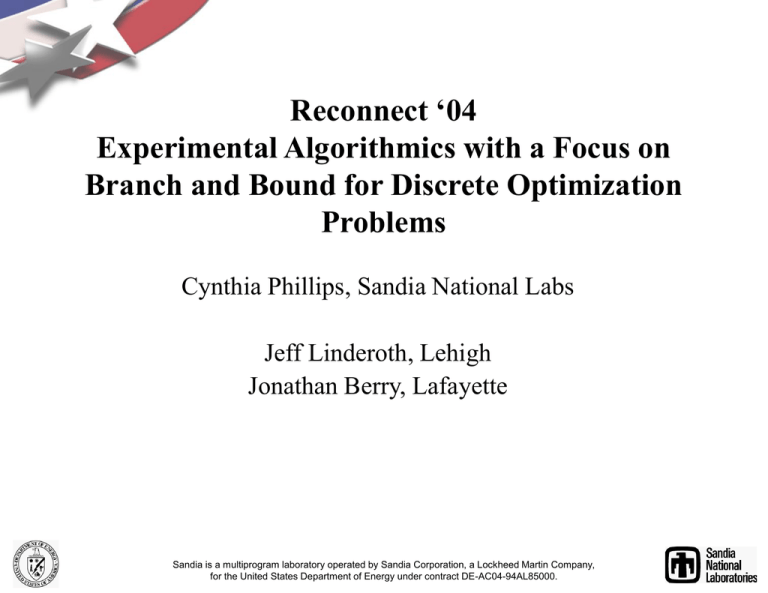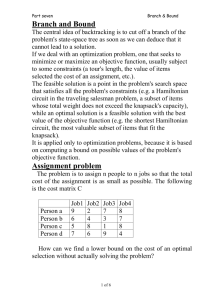Reconnect ‘04 Experimental Algorithmics with a Focus on Problems
advertisement

Reconnect ‘04
Experimental Algorithmics with a Focus on
Branch and Bound for Discrete Optimization
Problems
Cynthia Phillips, Sandia National Labs
Jeff Linderoth, Lehigh
Jonathan Berry, Lafayette
Sandia is a multiprogram laboratory operated by Sandia Corporation, a Lockheed Martin Company,
for the United States Department of Energy under contract DE-AC04-94AL85000.
Discrete (Combinatorial) Optimization
Informally, a Combinatorial Optimization problem is the minimization
(maximization) of an objective function over a finite set of feasible
solutions.
Examples from everyday life:
• Scheduling family activities (just finding a feasible solution)
– Vehicle routing
• Packing a moving van or dishwasher
• Budgeting
Slide 2
Complexity
Most of the problems we really want to solve are NP-complete: Any
algorithm that computes the optimal solution for all input instances is
likely to take an unacceptable amount of time in the worst case.
But we still need to solve them in practice:
• Approximation
• Restricted input instances
• Average Case
Slide 3
Solving Combinatorial Optimization Problems in Practice
Goal: Do the best we can in solving a particular instance.
• That’s what people really want to solve
• Structural insight from optimal solutions to small problems leads to
– Better approximation algorithms (theory)
– Better heuristics (practice)
– Better solution of bigger problems
Slide 4
Experimental Algorithmics
• Rigorous computer experimentation
– How well does an algorithm/implementation perform?
• Time, Approximation quality
– Algorithm comparisons
• Algorithmic questions arising during development of robust, efficient
software
– Cache issues
– Generation of synthetic data
• Algorithm Engineering
Slide 5
Branch and Bound
Branch and Bound is an intelligent (enumerative) search procedure for
discrete optimization problems.
min xX f (x)
Three required (problem-specific) procedures:
• Compute a lower bound (assuming min) b(X)
x X, b(X) f (x)
• Split a feasible region (e.g. over parameter/decision space)
• Find a candidate solution x X
– Can fail
– Require that it recognizes feasibility if X has only one point
Slide 6
Branching (Splitting)
• Usually partitions the feasible region (or better)
Slide 7
Branching (Splitting)
Region X
X1
X2
• Usually partitions the feasible region (or better)
Slide 8
X3
Branch and Bound
Root Problem = original
fathomed
infeasible
• Recursively divide feasible region, prune search when no optimal solution can be in the
region.
Slide 9
Terminology
• The best feasible solution found so far is called the incumbent.
• A node awaiting bounding or splitting (not done) is called active.
• The set of active nodes is sometimes called the frontier.
Slide 10
Branch and Bound Solution Quality
• At any point in the computation, we have a global lower bound: the
lowest lower bound among all open (active) nodes.
• We can stop at any point and compute an instance-specific
approximation bound: value of incumbent/global bound
• If B&B runs to completion we have
– Found an optimal solution
– Proven that this solution is optimal
Slide 11
Example: Binary Knapsack
Given set of objects 1..n
Each has weight/size wi, and value vi
Thief wants the most valuable set that fits into a knapsack of size W
Find a subset of objects S that
Maximizes
V (S) v i
iS
Subject to W (S)
iS
Slide 12
wi W
Binary Knapsack - Upper Bound (and Candidate)
• Bound with greedy strategy
– Maximize value/unit weight
• Sort objects by “bang for the buck”:
– Add objects in order
vi
wi
vi
– Split last object
wi
value
W
Slide 13
weight
Greedy Isn’t optimal
• Knapsack is weakly NP-complete
w
v
v/w
A
6
12
2
B
5
9
9/5
C
4
4
1
• For W = 9, {B,C} is optimal
Slide 14
Knapsack - Partitioning
Object i
Undecided
Take
Object
i
Leave
Object
i
Represent a decision region with three subsets: IN, OUT, UNDECIDED
Upper bound and candidate: (value of) greedy on
UNDECIDED with new bound W - W(IN).
Branch object (i above): The one partially-included item in the greedy solution
Slide 15
Branch and Bound
Root Problem: IN, OUT empty
Object i IN
Object j IN
infeasible
Object i OUT
Object j OUT
Object k IN
Object k OUT
fathomed
• Recursively divide feasible region, prune search when no optimal solution can be in the
region.
Slide 16
Representation - Space issues
Two Lists (IN and OUT)
UNDECIDED is implied
IN,OUT
Object i IN
Object i OUT
IN,OUT
i
IN i,OUT
Slide 17
Share OUT with parent
Share IN with parent
Representation Issue - Space
Object i IN
Object j IN
Object i OUT
Object j OUT
Object k IN
• 3-valued vector: IOU
• Save difference with parent
• Issue: length of chains vs. space cost of replication
Slide 18
Object k OUT
This course covers
• Practical ways to solve combinatorial optimization problems with
branch and bound
• Integer Programming
– Natural general way to express any NP-complete problem (most
useful combinatorial optimization problems)
– Theoretical foundations as relevant to practice
– Software tools
• Experimental Algorithmics
– Answering “so what?” for your experimental study
We’ll see example applications, but they’re the tip of the iceberg
Slide 19





